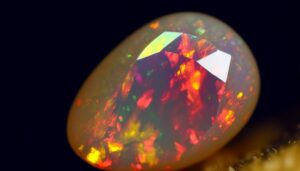How Is Ethiopian Fire Opal Unique Among Gemstones?
Ethiopian Fire Opal is a striking gemstone known for its vivid play-of-color, ranging from bright oranges to deep reds. It originates from the Wollo Province in Ethiopia, discovered in 1994, and forms within silica-rich deposits resulting from ancient volcanic activity.
The microstructure of these opals diffracts light to create their dynamic color patterns. These gems vary in transparency and are typically shaped into cabochons or faceted stones to enhance their brilliance.
When evaluating Ethiopian Fire Opal, consider the intensity of its color play and clarity. Enhance your knowledge of this unique stone's formation, care, and market value further.
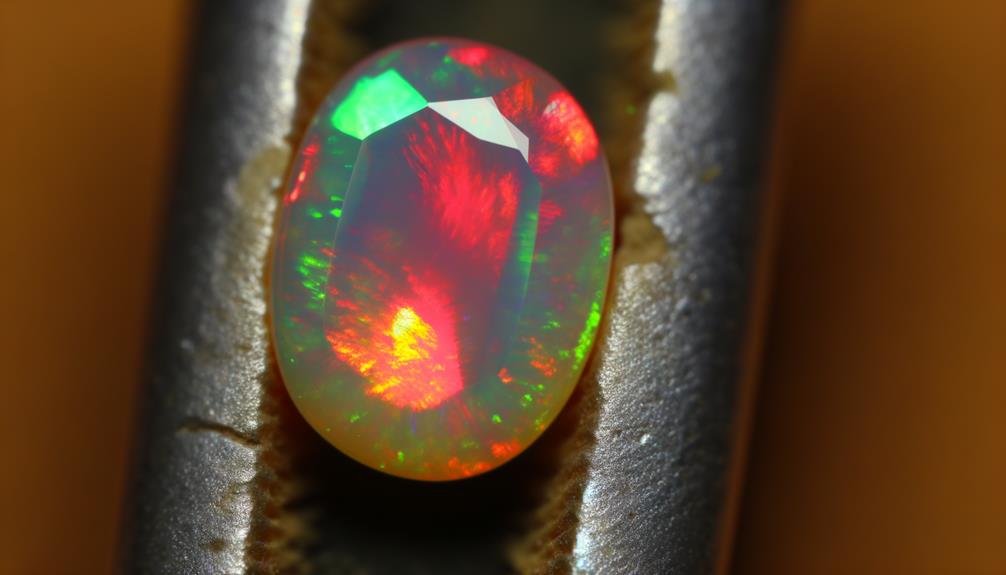
Key Takeaways
- Ethiopian Fire Opal is a gemstone known for its vivid play-of-color, ranging from bright oranges to deep reds.
- It originates from volcanic rock formations in Wollo Province, Ethiopia, discovered in 1994.
- The gemstone forms within silica-rich deposits due to intense volcanic activity in Ethiopia's Rift Valley.
- Transparency varies from opaque to transparent, enhancing its dynamic color patterns and brilliance.
- It is highly valued in fine jewelry and sought after for its unique optical properties and vibrant hues.
Origins of Ethiopian Fire Opal

Ethiopian Fire Opal, a mesmerizing gemstone known for its vibrant play-of-color, originates from the Wollo Province in the northern part of Ethiopia, where volcanic activity and geological conditions have created an ideal environment for its formation.
You'll find this opal forms in rhyolitic volcanic rocks, rich in silica. The volatile environment causes rapid cooling, leading to the creation of cavities where silica spheres can form. These spheres arrange in a periodic structure, diffracting light and producing the gemstone's characteristic play-of-color.
The opal's body color ranges from clear to vibrant orange and red, often with a translucent quality. Understanding these origins helps you appreciate the gem's unique optical properties and the intricate geological processes that bring these stunning colors to life.
Discovery in Wollo Province
The discovery of Fire Opal in the Wollo Province can be traced back to 1994 when local miners first unearthed these enchanting gems, sparking a geological and gemological interest that rapidly gained international attention.
You'll find that these opals are characterized by their vivid play-of-color, ranging from fiery reds to deep oranges. Initial findings revealed opals embedded within volcanic rock formations, often requiring meticulous extraction techniques.
These gems were notable for their high transparency and striking color patterns, distinguishing them from other opal varieties.
As you explore further, you'll notice the mining activities expanded significantly, driven by global demand. Understanding the early extraction methods and subsequent operational developments offers a detailed insight into the Wollo Province's mining evolution.
Geological Formation
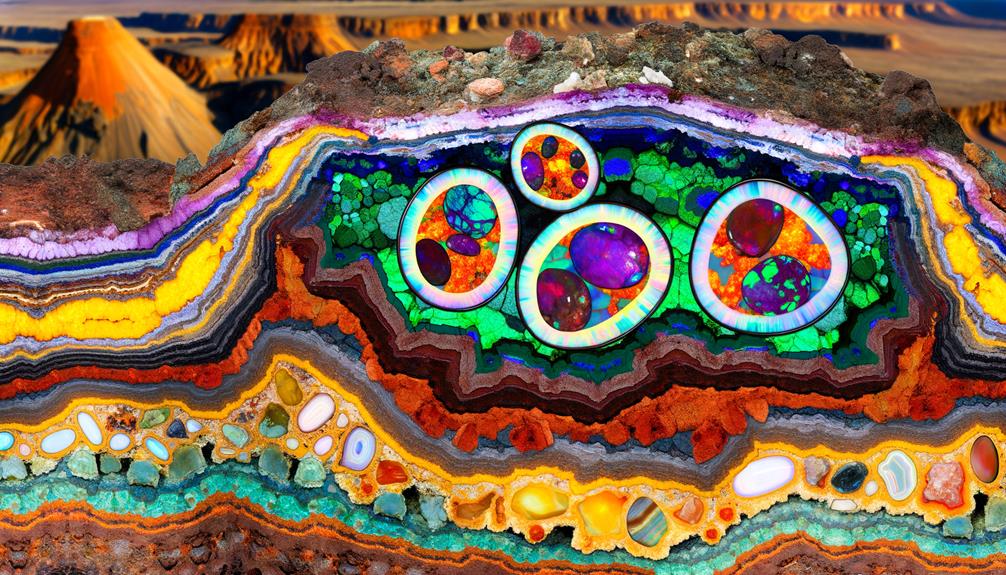
When you examine the geological formation of Ethiopian Fire Opal, you'll find that its origins lie in intense volcanic activity.
The unique environmental conditions, including high silica content and rapid cooling, contribute to the opal's vibrant play-of-color.
This milieu creates an ideal setting for the formation of these stunning gemstones.
Volcanic Activity Origins
Through the interplay of tectonic movements and volcanic eruptions, fire opals form within the silica-rich deposits of Ethiopia's Rift Valley, where geothermal activity drives the mineral crystallization process. As magma ascends through volcanic fissures, it cools and solidifies, trapping silica-rich fluids.
You witness the following steps during this unique geological phenomenon:
- Silica Saturation: Groundwater percolates through volcanic ash layers, becoming saturated with silica.
- Hydrothermal Activity: Heat from volcanic activity causes the silica-laden water to precipitate, forming opal.
- Rapid Cooling: Quick cooling of the silica solution leads to the formation of the opal's unique play-of-color.
These processes result in the vibrant Ethiopian fire opals, renowned for their intense coloration and fiery brilliance.
Unique Environmental Conditions
Ethiopia's unique environmental conditions, characterized by its geothermal hotspots and mineral-rich volcanic ash, create the perfect setting for the formation of fire opals. These opals crystallize in rhyolitic volcanic rocks, where silica-rich fluids percolate through fractures. The geothermal heat accelerates the formation process, while mineral deposits from volcanic ash contribute essential elements.
| Environmental Factor | Description | Impact on Opals |
|---|---|---|
| Geothermal Hotspots | Areas with elevated geothermal heat | Accelerates crystallization |
| Volcanic Ash | Silica and minerals from eruptions | Provides essential elements |
| Rhyolitic Rocks | Volcanic rock type | Hosts opal formation |
| Silica-rich Fluids | Percolating water with silica | Forms opal structure |
| Fractures in Rocks | Pathways for fluid movement | Facilitates deposition |
These factors synergize to create fire opals with vibrant color play and unique structural properties.
Unique Physical Properties
When examining Ethiopian Fire Opal, you'll notice its exceptional vivid color play, ranging from bright oranges to deep reds, which results from the diffraction of light through its silica structure.
The gemstone's transparency and clarity often surpass that of other opals, allowing for a more intense and consistent display of these colors.
These unique physical properties make Ethiopian Fire Opal highly prized in both gemological and jewelry contexts.
Vivid Color Play
Boasting an unparalleled spectrum of colors, the Ethiopian Fire Opal dazzles with its striking play-of-color phenomenon, characterized by the dynamic interplay of vibrant hues that shift with the angle of light.
You'll notice the gem's ability to refract light into a kaleidoscope of colors, making it a sought-after specimen for collectors and jewelers alike.
The primary factors contributing to this vivid color play include:
- Microstructure: The internal structure contains silica spheres that diffract light, creating dynamic color patterns.
- Hydration Levels: Higher water content enhances the gem's ability to display colors.
- Angle of Observation: Varying viewpoints alter the light interaction, showcasing different color spectrums.
Understanding these factors helps you appreciate the technical marvel that's the Ethiopian Fire Opal.
Transparency and Clarity
In addition to its mesmerizing color play, the Ethiopian Fire Opal's transparency and clarity are key factors that greatly enhance its overall visual appeal and value. You'll find that these gemstones exhibit varying degrees of transparency, ranging from fully transparent to translucent. High clarity, with minimal inclusions, allows light to pass through the gem, intensifying its vibrant color play.
Here's a breakdown:
| Transparency Level | Description |
|---|---|
| Transparent | Clear, with no visible inclusions |
| Translucent | Somewhat clear, slight inclusions |
| Opaque | No light passes through, many inclusions |
Transparent Ethiopian Fire Opals are the most coveted, as their clarity maximizes the internal fire display. Understanding these properties helps you appreciate their uniqueness and value.
Play of Color
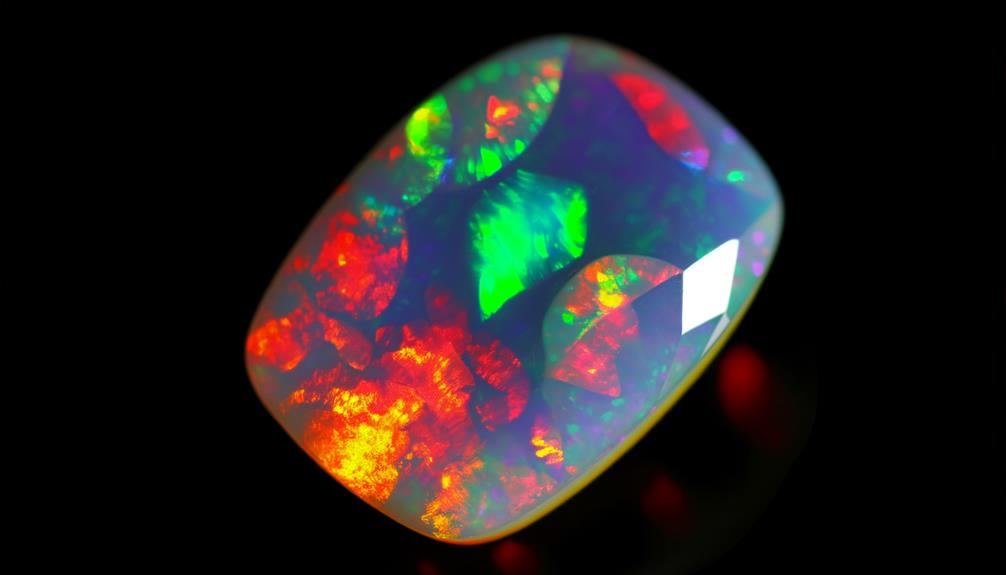
The Ethiopian Fire Opal exhibits a remarkable play of color, characterized by a dynamic interplay of spectral hues that shift with the angle of light. You'll notice that this phenomenon, known as 'opalescence,' results from the diffraction of light within the microstructure of silica spheres.
The intensity and range of colors can vary dramatically, often featuring vivid reds, greens, and blues.
To better understand this phenomenon, consider the following factors:
- Light Source: The color play is most pronounced under natural sunlight or a full-spectrum light.
- Viewing Angle: Tilting the opal can reveal different colors as light diffracts at various angles.
- Silica Sphere Size: Variations in sphere size within the structure affect which colors are visible.
Types and Varieties
You'll find Ethiopian Fire Opals exhibit a diverse play-of-color spectrum, ranging from vibrant reds and oranges to subtle blues and greens.
These opals vary in transparency levels, encompassing clear, translucent, and opaque forms.
They're commonly cut into cabochons or faceted shapes to best enhance their unique optical properties.
Play-of-Color Spectrum
Exploring the play-of-color spectrum in Ethiopian Fire Opals reveals an array of vibrant hues, ranging from neon greens and bold reds to deep blues and striking purples, each caused by intricate microstructures within the gem. These microstructures, known as silica spheres, diffract light to produce the mesmerizing colors.
You'll find that the play-of-color can be categorized into three primary types:
- Pinfire: Displays small, pinpoint flashes of color.
- Harlequin: Features a patchwork of large, angular color patches.
- Flash: Exhibits broad, sweeping areas of color movement.
Understanding these varieties enhances your appreciation and ability to identify quality Ethiopian Fire Opals. Each type offers unique visual experiences, making this gem a favorite among collectors.
Transparency Levels
Understanding the transparency levels of Ethiopian Fire Opals involves examining various types and varieties, ranging from completely opaque to nearly transparent, each offering unique characteristics and visual appeal.
Opaque Ethiopian Fire Opals, often showcasing intense body color, lack light transmission but display vivid play-of-color.
Semi-transparent varieties allow partial light penetration, enhancing their internal play-of-color, while maintaining a distinct body color.
Transparent Ethiopian Fire Opals, sometimes called “crystal opals,” exhibit the highest degree of light transmission. These opals can present a mesmerizing, three-dimensional play-of-color, seemingly suspended within the stone.
Each level of transparency impacts the gem's overall aesthetics, allowing you to select the type that best suits your preference for visual complexity and brilliance.
Common Shapes
When considering the common shapes of Ethiopian Fire Opals, you'll encounter a range of meticulously cut forms such as cabochons, faceted stones, and freeform shapes, each designed to maximize the gemstone's inherent play-of-color and brilliance.
Cabochons, with their smooth, rounded surfaces, are particularly effective in showcasing the opal's vibrant color play.
Faceted stones, on the other hand, are cut with multiple flat surfaces to enhance light reflection, adding a scintillating effect.
Freeform shapes offer a more naturalistic appeal, often tailored to the opal's unique structure.
Here are three common shapes:
- Cabochons: Smooth, non-faceted, rounded surfaces.
- Faceted Stones: Multiple flat surfaces for light reflection.
- Freeform Shapes: Custom cuts based on the stone's natural contours.
Mining Techniques

Ethiopia's mining techniques for fire opal involve a combination of traditional hand tools and modern machinery to carefully extract the delicate gemstones from volcanic rock formations.
You'll see miners using chisels and hammers to manually break the rock, guaranteeing minimal damage to the opals. Pneumatic drills and mechanized excavators are also employed to reach deeper layers.
The process includes detailed geological assessments to locate opal-rich veins. Miners often work in narrow tunnels where precision is essential, and constant monitoring of structural stability is vital to prevent collapses.
Once extracted, the rough opals undergo initial sorting and evaluation on-site before being transported for further processing. This meticulous approach guarantees the high quality of Ethiopian fire opals.
Treatment and Enhancement
Treatment and enhancement of Ethiopian fire opals involve precise techniques such as heat treatments and resin impregnation to improve color vibrancy and structural integrity.
You'll often find these opals undergo:
- Heat Treatment: This process elevates the opal's temperature to enhance its internal play-of-color, creating a more vivid visual effect.
- Resin Impregnation: A specialized resin fills micro-fractures, bolstering the opal's durability and reducing the risk of cracking.
- Smoke Treatment: Introducing carbon particles through controlled smoking intensifies color depth and contrast.
Each method requires careful control to avoid over-treatment, which could compromise the opal's natural appeal.
Market Value
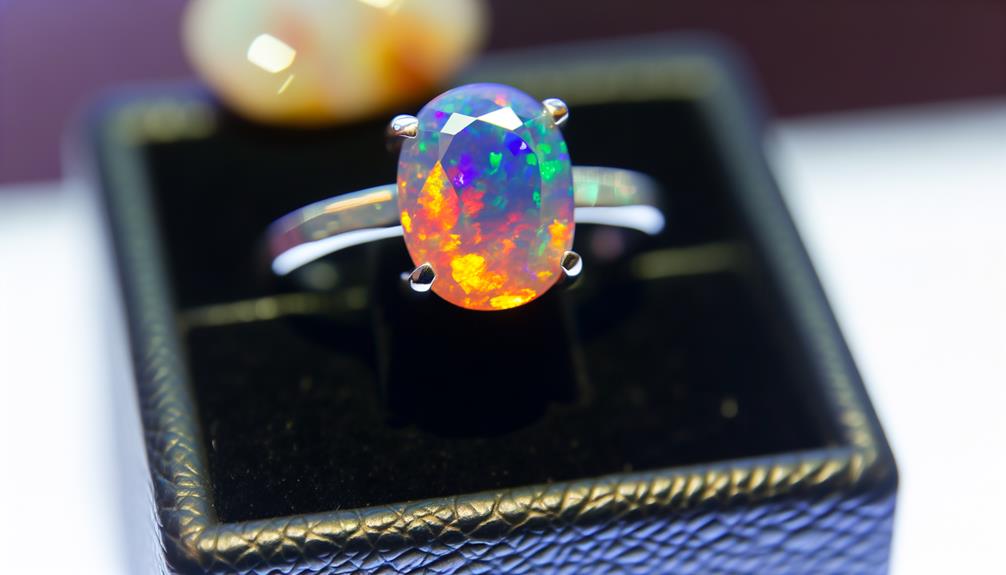
Regularly fluctuating based on quality, rarity, and demand, the market value of Ethiopian fire opals is carefully evaluated to reflect their unique characteristics and enhancements.
You'll find that higher-quality opals, particularly those with vibrant color play and minimal inclusions, command premium prices. Rarity greatly influences value, with larger, flawless specimens being more desirable.
Enhancements like hydrophane treatment can also impact value, either positively or negatively, depending on market perception. Demand trends play an essential role; a surge in popularity can drive prices up.
Dealers often use calibrated scales to measure carat weight, transparency, and optical brilliance, ensuring precise valuation. By understanding these factors, you can better navigate the market and make informed purchasing decisions.
Popular Uses
Given their stunning visual appeal and varying market values, Ethiopian fire opals are highly sought after for use in fine jewelry, including rings, necklaces, and earrings. Their vibrant play-of-color and translucence make them a favorite choice for statement pieces.
You can find these gems in:
- Rings: Ethiopian fire opals are often set in intricate ring designs, showcasing their radiant hues.
- Necklaces: Pendant necklaces leverage the opal's vivid colors to create a focal point.
- Earrings: Whether in studs or dangles, these opals provide a mesmerizing sparkle.
Each application highlights the gemstone's unique optical properties, making them versatile for both casual and formal wear. Their adaptability in various jewelry settings underscores their desirability among collectors and fashion enthusiasts.
Care and Maintenance
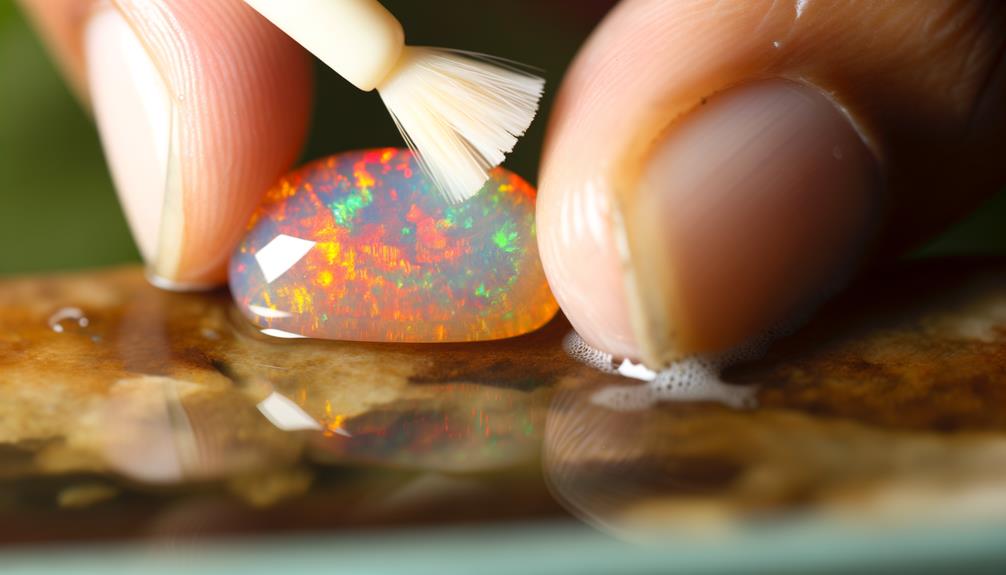
To preserve the brilliance and structural integrity of your Ethiopian fire opal, you need to follow specific care and maintenance guidelines meticulously.
First and foremost, avoid exposing the opal to extreme temperature fluctuations, which can cause cracking. Store it in a padded jewelry box, away from direct sunlight or heat sources.
Clean the opal with a soft, damp cloth; avoid using chemical cleaners or ultrasonic devices, as they can damage the stone. To maintain hydration, occasionally soak the opal in water for a few minutes.
Also, minimize physical impact by removing the opal before engaging in strenuous activities.
Buying Tips
When purchasing an Ethiopian fire opal, examine the stone's color display, clarity, and cut to guarantee you're acquiring a high-quality gem.
Evaluate the opal's vivid and multi-colored play of hues; the more vibrant the colors, the more valuable the stone.
Assess clarity by searching for inclusions or haziness that may reduce its brilliance.
The cut should enhance the opal's innate beauty, maximizing its visual performance.
Consider these three key factors:
- Color Display: Look for a wide range of colors with a high level of intensity.
- Clarity: Ensure minimal inclusions and a transparent appearance.
- Cut: Inspect for a cut that optimizes the stone's color display and overall aesthetic.
These elements collectively determine the gem's quality and worth.
Conclusion
You've now got the scoop on Ethiopian fire opals, a stunning gem from Wollo Province. These treasures form through unique geological processes, boasting a mesmerizing play of color.
While their market value can vary, they're highly sought after for jewelry. To maintain their beauty, handle with care. When buying, scrutinize the gem's quality.
Immerse yourself in the world of Ethiopian fire opals and let their vibrant hues add a touch of elegance to your collection.


